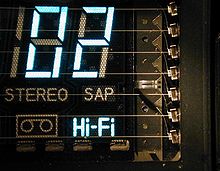
Back Visualitzador fluorescent de buit Catalan Fluoreszenzanzeige German Visualizador fluorescente de vacío Spanish Tyhjiöfluoresenssinäyttö Finnish Afficheur fluorescent French Fluorescentni zaslon Croatian Display fluorescente a vuoto Italian 蛍光表示管 Japanese 진공 형광 디스플레이 Korean Vacuümfluorescentiedisplay Dutch




|

|

|
| 7 segments |
8 segments (Sharp EL-8) |
16 segments |
A vacuum fluorescent display (VFD) is a display device once commonly used on consumer electronics equipment such as video cassette recorders, car radios, and microwave ovens.
A VFD operates on the principle of cathodoluminescence, roughly similar to a cathode-ray tube, but operating at much lower voltages. Each tube in a VFD has a phosphor-coated carbon anode that is bombarded by electrons emitted from the cathode filament.[1][2] In fact, each tube in a VFD is a triode vacuum tube because it also has a mesh control grid.[3]
Unlike liquid crystal displays (LCDs), a VFD emits very bright light with high contrast and can support display elements of various colors. Standard illumination figures for VFDs are around 640 cd/m2 with high-brightness VFDs operating at 4,000 cd/m2, and experimental units as high as 35,000 cd/m2 depending on the drive voltage and its timing.[3] The choice of color (which determines the nature of the phosphor) and display brightness significantly affect the lifetime of the tubes, which can range from as low as 1,500 hours for a vivid red VFD to 30,000 hours for the more common green ones.[3] Cadmium was commonly used in the phosphors of VFDs in the past, but the current RoHS-compliant VFDs have eliminated this metal from their construction, using instead phosphors consisting of a matrix of alkaline earth and very small amounts of group III metals, doped with very small amounts of rare earth metals.[4]
VFDs can display seven-segment numerals, multi-segment alpha-numeric characters or can be made in a dot-matrix to display different alphanumeric characters and symbols. In practice, there is little limit to the shape of the image that can be displayed: it depends solely on the shape of phosphor on the anode(s).
The first VFD was the single indication DM160 by Philips in 1959.[5] The first multi-segment VFD was a 1967 Japanese single-digit, seven-segment device made by Ise Electronics Corporation.[6] The displays became common on calculators and other consumer electronics devices.[7] In the late 1980s hundreds of millions of units were made yearly.[8]
- ^ Shigeo Shionoya; William M. Yen (1998). Phosphor Handbook. CRC Press. p. 561. ISBN 978-0-8493-7560-6.
- ^ Chen, J., Cranton, W., & Fihn, M. (Eds.). (2016). Handbook of Visual Display Technology. doi:10.1007/978-3-319-14346-0 page 1610 onwards
- ^ a b c Janglin Chen; Wayne Cranton; Mark Fihn (2011). Handbook of Visual Display Technology. Springer. pp. 1056, 1067–1068. ISBN 978-3-540-79566-7.
- ^ "Fluorescent phosphorescent coating free from sulphur and cadmium". Archived from the original on 2021-02-02. Retrieved 2020-10-03.
- ^ (HB9RXQ), Ernst Erb. "DM 160, Tube DM160; Röhre DM 160 ID19445, INDICATOR, in gene". www.radiomuseum.org. Archived from the original on 2012-01-13. Retrieved 2012-08-13.
{{cite web}}: CS1 maint: numeric names: authors list (link) - ^ Kiyozumi, K., & Nakamura, T. (1983). Vacuum fluorescent displays: from single digits to colour TV. Displays, 4(4), 213–220. doi:10.1016/0141-9382(83)90116-6
- ^ Joseph A. Castellano (ed), Handbook of display technology Gulf Professional Publishing, 1992 ISBN 0-12-163420-5 page 9
- ^ Joseph A. Castellano (ed), Handbook of display technology Gulf Professional Publishing, 1992 ISBN 0-12-163420-5 page 176